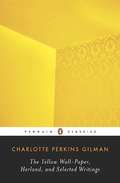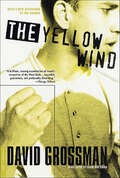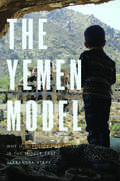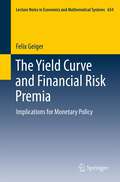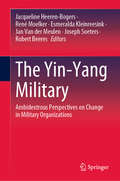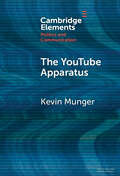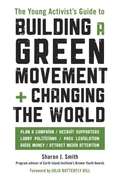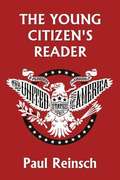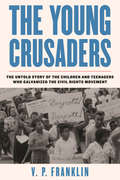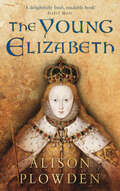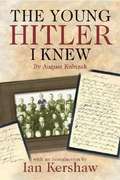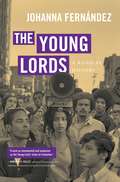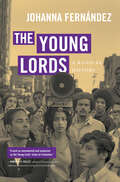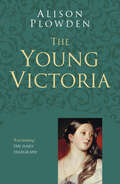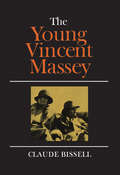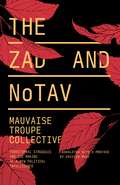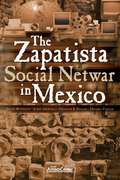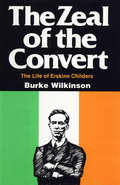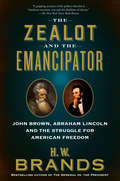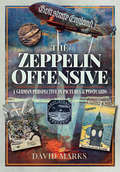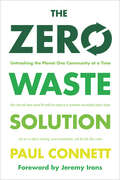- Table View
- List View
The Yellow Wall-paper, Herland, and Selected Writings
by Charlotte Perkins GilmanWonderfully sardonic and slyly humorous, the writings of landmark American feminist and socialist thinker Charlotte Perkins Gilman were penned in response to her frustrations with the gender-based double standard that prevailed in America as the twentieth century began. Perhaps best known for her chilling depiction of a woman's mental breakdown in her unforgettable 1892 short story 'The Yellow Wall-Paper', Gilman also wrote Herland, a wry novel that imagines a peaceful, progressive country from which men have been absent for 2,000 years. Both are included in this volume, along with a selection of Gilman's major short stories and her poems.
The Yellow Wind: A History
by David GrossmanDavid Grossman's The Yellow Wind is essential reading for anyone who seeks a deeper understanding of Israel today. The Israeli novelist David Grossman's impassioned account of what he observed on the West Bank in early 1987—not only the misery of the Palestinian refugees and their deep-seated hatred of the Israelis but also the cost of occupation for both occupier and occupied—is an intimate and urgent moral report on one of the great tragedies of our time. This edition includes a new afterword by the author.
The Yemen Model: Why U.S. Policy Has Failed in the Middle East
by Alexandra StarkA close look at failed U.S. policies in the Middle East, offering a fresh perspective on how best to reorient goals in the region In this book Alexandra Stark argues that the U.S. approach to Yemen offers insights into the failures of American foreign policy throughout the Middle East. Stark makes the case that despite often being drawn into conflicts within Yemen, the United States has not achieved its policy goals because it has narrowly focused on counterterrorism and regional geopolitical competition rather than on the well-being of Yemenis themselves. She offers recommendations designed to reorient U.S. policy in the Middle East in pursuit of U.S. national security interests and to support the people of these countries in their efforts to make their own communities safe, secure, and prosperous.
The Yield Curve and Financial Risk Premia: Implications for Monetary Policy
by Felix GeigerThe determinants of yield curve dynamics have been thoroughly discussed in finance models. However, little can be said about the macroeconomic factors behind the movements of short- and long-term interest rates as well as the risk compensation demanded by financial investors. By taking on a macro-finance perspective, the book's approach explicitly acknowledges the close feedback between monetary policy, the macroeconomy and financial conditions. Both theoretical and empirical models are applied in order to get a profound understanding of the interlinkages between economic activity, the conduct of monetary policy and the underlying macroeconomic factors of bond price movements. Moreover, the book identifies a broad risk-taking channel of monetary transmission which allows a reassessment of the role of financial constraints; it enables policy makers to develop new guidelines for monetary policy and for financial supervision of how to cope with evolving financial imbalances.
The Yield Curve and Financial Risk Premia: Implications for Monetary Policy (Lecture Notes in Economics and Mathematical Systems #654)
by Felix GeigerThe determinants of yield curve dynamics have been thoroughly discussed in finance models. However, little can be said about the macroeconomic factors behind the movements of short- and long-term interest rates as well as the risk compensation demanded by financial investors. By taking on a macro-finance perspective, the book’s approach explicitly acknowledges the close feedback between monetary policy, the macroeconomy and financial conditions. Both theoretical and empirical models are applied in order to get a profound understanding of the interlinkages between economic activity, the conduct of monetary policy and the underlying macroeconomic factors of bond price movements. Moreover, the book identifies a broad risk-taking channel of monetary transmission which allows a reassessment of the role of financial constraints; it enables policy makers to develop new guidelines for monetary policy and for financial supervision of how to cope with evolving financial imbalances.
The Yin-Yang Military: Ambidextrous Perspectives on Change in Military Organizations
by Joseph Soeters Robert Beeres René Moelker Jacqueline Heeren-Bogers Esmeralda Kleinreesink Jan Van der MeulenThis book examines change processes and the challenge of ambidexterity in military organizations. It discusses how military organizations can better adapt to the complex, and at times chaotic, environments they operate in by developing organizational ambidexterity. The authors identify various multiple tasks and functions of military organizations that require multi-dimensional and often contradictory operational, technological, cultural, and social skills. In analogy to the often-opposed functions performed by the right and left hand of the body, modern military organizations are no longer one-dimensional fighting machines, but characterized by a duality of tasks, such as fighting and peacekeeping which often make part and parcel of one and the same mission. The military is both a “hot” and a “cold” organization (a crisis management organization and a bureaucracy). As such, the book argues that these dualities are not necessarily opposed but can serve as complementary forces, like the yin and yang, to better the overall performance of these organizations. As a consequence, ambidextrous organizations excel at complex tasking and are adaptable to new challenges. Divided into four parts: 1) structures and networks; 2) cultural issues; 3) tasks and roles; 4) nations and allies, it appeals to scholars of military studies and organization studies as well as professionals working for governmental or military organizations.
The YouTube Apparatus (Elements in Politics and Communication)
by Kevin MungerThe academic agenda for studying social media and politics has been somewhat haphazard. Thanks to rapid technological change, a cascade of policy-relevant crises, and sheer scale, we do not have a coherent framework for deciding what questions to ask. This Element articulates such a framework by taking existing literature from media economics and sociology and applying it reflexively, to both the academic agenda and to the specific case of politics on YouTube: the Supply and Demand Framework. The key mechanism, traced over the past century, is the technology of audience measurement. The YouTube audience comes pre-rationalized in the form of Likes, Views and Comments, and is thus unavoidable for all actors involved. The phenomenon of 'radicalization' is best understood as a consequence of accelerated feedback between audiences and creators, radicalizing each other. I use fifteen years of supply and demand data from YouTube to demonstrate how different types of producers respond more or less to this feedback, which in turn structures the ideological distribution of content consumed on the platform.
The Young Activist's Guide to Building a Green Movement + Changing the World
by Sharon J. SmithIf you want to make a significant and sustainable impact on the health of our planet, this powerful and practical guide can help. Author and activist Sharon J. Smith shares proven strategies and lessons learned from the winners of Earth Island Institute#x19;s Brower Youth Awards-America#x19;s top honor for young green leaders. Here are all the tools you need-from planning a campaign and recruiting supporters to raising money and attracting media attention-to turn your ideas into actions and make changes that matter. All author proceeds from the sale of this book go to Earth Island Institute#x19;s Brower Youth Awards to support the next generation of young activists.
The Young Citizen's Reader
by Paul ReinschDescribes the essential methods of political action at the town, state, and national level to lead boys and girls to notice and understand what is going on about them. Attention is then directed to the structure of the state in all its parts with a view to informing intelligent action in matters of politics.
The Young Crusaders: The Untold Story of the Children and Teenagers Who Galvanized the Civil Rights Movement
by V.P. FranklinAn authoritative history of the overlooked youth activists that spearheaded the largest protests of the Civil Rights Movement and set the blueprint for future generations of activists to follow.Some of the most iconic images of the Civil Rights Movement are those of young people engaged in social activism, such as children and teenagers in 1963 being attacked by police in Birmingham with dogs and water hoses. But their contributions have not been well documented or prioritized. The Young Crusaders is the first book dedicated to telling the story of the hundreds of thousands of children and teenagers who engaged in sit-ins, school strikes, boycotts, marches, and demonstrations in which Dr. Martin Luther King Jr. and other national civil rights leaders played little or no part.It was these young activists who joined in the largest civil rights demonstration in US history: the system-wide school boycott in New York City on February 3, 1964, where over 360,000 elementary and secondary school students went on strike and thousands attended freedom schools. Later that month, tens of thousands of children and teenagers participated in the "Freedom Day" boycotts in Boston and Chicago, also demanding "quality integrated education."Distinguished historian V. P. Franklin illustrates how their ingenuity made these and numerous other campaigns across the country successful in bringing about the end to legalized racial discrimination. It was these unheralded young people who set the blueprint for today's youth activists and their campaigns to address poverty, joblessness, educational inequality, and racialized violence and discrimination. Understanding the role of children and teenagers transforms how we understand the Civil Rights Movement and the broader part young people have played in shepherding social and educational progress, and it serves as a model for the youth-led "reparatory justice" campaigns seen today mounted by Black Lives Matter, March for Our Lives, and the Sunrise Movement.Highlighting the voices of the young people themselves, Franklin offers a redefining narrative, complemented by arresting archival images. The Young Crusaders reveals a radical history that both challenges and expands our understanding of the Civil Rights Movement.
The Young Eagle: The Rise Of Abraham Lincoln
by Kenneth J. WinkleDrawing on the latest interpretive and methodological advances in historical scholarship, The Young Eagle: The Rise of Abraham Lincoln reexamines the young adult life of America's sixteenth president.
The Young Elizabeth
by Alison PlowdenElizabeth I is perhaps England's most famous monarch. Born in 1533, the product of the doomed marriage of Henry VIII and Anne Boleyn, Elizabeth was heir to her father's title, then disinherited and finally imprisoned her half sister Mary. Her childhood was one of fear and danger, she was aware from the outset that the eyes of the world were upon her and that to survive she would have to rely on her own judgement and strength of character. Many tried to use her for their own ends, however she rose out of the shadows and on the death of her sister, she became Gloriana - England's most iconic queen.
The Young Hitler I Knew
by Ian Kershaw August Kubizek Geoffrey BrooksThis is the first edition to be published in English since 1955 and it corrects many changes made for reasons of political correctness. It also includes important sections which were excised from the original English translation. August Kubizek met Adolf Hitler in 1904 while they were both competing for standing room at the opera. Their mutual passion for music created a strong bond, and over the next four years they became close friends. Kubizek describes a reticent young man, painfully shy, yet capable of bursting into hysterical fits of anger if anyone disagreed with him. The two boys would often talk for hours on end; Hitler found Kubizek to be a very good listener, a worthy confidant to his hopes and dreams. In 1908 Kubizek moved to Vienna and shared a room with Hitler at 29 Stumpergasse. During this time, Hitler tried to get into art school, but he was unsuccessful. With his money fast running out, he found himself sinking to the lower depths of the city: an unkind world of isolation and 'constant unappeasable hunger'. Hitler moved out of the flat in November, without leaving a forwarding address; Kubizek did not meet his friend again until 1938. The Young Hitler I Knew tells the story of an extraordinary friendship, and gives fascinating insight into Hitler's character during these formative years. A must for Hitler scholars.
The Young Lords: A Radical History
by Johanna FernándezAgainst the backdrop of America's escalating urban rebellions in the 1960s, an unexpected cohort of New York radicals unleashed a series of urban guerrilla actions against the city's racist policies and contempt for the poor. Their dramatic flair, uncompromising vision, and skillful ability to link local problems to international crises riveted the media, alarmed New York's political class, and challenged nationwide perceptions of civil rights and black power protest. The group called itself the Young Lords.
The Young Lords: A Radical History
by Johanna FernándezAgainst the backdrop of America's escalating urban rebellions in the 1960s, an unexpected cohort of New York radicals unleashed a series of urban guerrilla actions against the city's racist policies and contempt for the poor. Their dramatic flair, uncompromising socialist vision for a new society, skillful ability to link local problems to international crises, and uncompromising vision for a new society riveted the media, alarmed New York's political class, and challenged nationwide perceptions of civil rights and black power protest. The group called itself the Young Lords.Utilizing oral histories, archival records, and an enormous cache of police surveillance files released only after a decade-long Freedom of Information Law request and subsequent court battle, Johanna Fernandez has written the definitive account of the Young Lords, from their roots as a Chicago street gang to their rise and fall as a political organization in New York. Led by poor and working-class Puerto Rican youth, and consciously fashioned after the Black Panther Party, the Young Lords occupied a hospital, blocked traffic with uncollected garbage, took over a church, tested children for lead poisoning, defended prisoners, fought the military police, and fed breakfast to poor children. Their imaginative, irreverent protests and media conscious tactics won reforms, popularized socialism in the United States and exposed U.S. mainland audiences to the country's quiet imperial project in Puerto Rico. Fernandez challenges what we think we know about the sixties. She shows that movement organizers were concerned with finding solutions to problems as pedestrian as garbage collection and the removal of lead paint from tenement walls; gentrification; lack of access to medical care; childcare for working mothers; and the warehousing of people who could not be employed in deindustrialized cities. The Young Lords' politics and preoccupations, especially those concerning the rise of permanent unemployment foretold the end of the American Dream. In riveting style, Fernandez demonstrates how the Young Lords redefined the character of protest, the color of politics, and the cadence of popular urban culture in the age of great dreams.
The Young Turks' Crime against Humanity: The Armenian Genocide and Ethnic Cleansing in the Ottoman Empire (Human Rights and Crimes Against Humanity #15)
by Taner AkçamAn unprecedented look at secret documents showing the deliberate nature of the Armenian genocideIntroducing new evidence from more than 600 secret Ottoman documents, this book demonstrates in unprecedented detail that the Armenian Genocide and the expulsion of Greeks from the late Ottoman Empire resulted from an official effort to rid the empire of its Christian subjects. Presenting these previously inaccessible documents along with expert context and analysis, Taner Akçam's most authoritative work to date goes deep inside the bureaucratic machinery of Ottoman Turkey to show how a dying empire embraced genocide and ethnic cleansing.Although the deportation and killing of Armenians was internationally condemned in 1915 as a "crime against humanity and civilization," the Ottoman government initiated a policy of denial that is still maintained by the Turkish Republic. The case for Turkey's "official history" rests on documents from the Ottoman imperial archives, to which access has been heavily restricted until recently. It is this very source that Akçam now uses to overturn the official narrative.The documents presented here attest to a late-Ottoman policy of Turkification, the goal of which was no less than the radical demographic transformation of Anatolia. To that end, about one-third of Anatolia's 15 million people were displaced, deported, expelled, or massacred, destroying the ethno-religious diversity of an ancient cultural crossroads of East and West, and paving the way for the Turkish Republic.By uncovering the central roles played by demographic engineering and assimilation in the Armenian Genocide, this book will fundamentally change how this crime is understood and show that physical destruction is not the only aspect of the genocidal process.
The Young Victoria: Classic Histories Series (Classic Histories Series)
by Alison Plowden'I delight in this work', wrote the young Victoria shortly after she became Queen. She was an engaging creature, high-spirited and eager to be 'amused'. But her early years were difficult ones. Fatherless from the age of eight months, she was brought up at Kensington Palace in an atmosphere thick with family feuds, backbiting and jealousy - the focus of conflicting ambitions. Though her uncle William IV was anxious to bring her into Court circles, her German mother and the calculating John Conroy were equally determined that she should remain under their control. The 'little Queen', who succeeded to the throne a month after her eighteenth birthday, was greeted by a unanimous chorus of praise and admiration. She embraced the independence of her position and often forced her will on those around her. She met and married Albert, marking the end of her childhood and the beginning of a glorious legend. Alison Plowden was one of the most successful and popular historians of British history. Her bestselling books include: The House of Tudor, The Young Elizabeth, Lady Jane Grey and Danger to Elizabeth, all of which are available from The History Press.
The Young Vincent Massey
by Claude BissellFor Vincent Massey, youth was a period of protest and emerging public fame. He broke with his strong family traditions of Methodist piety and American ties. He became known as a patron of the arts, innovator, politician, and diplomat.This volume begins with his prosperous Victorian childhood and carries through days as a student and wartime officer. He plans Hart House, which becomes a cultural centre. Promised a cabinet post, he runs for Parliament and is defeated. Instead, he is sent to Washington as Canada's first minister there, and achieves brilliant success. He is prominent in educational circles; he helps to reorganize the Liberal party, presses for progressive policies, and flirts with the idea of replacing Mackenzie King.The book ends in 1935 as he sails to London as his country's high commissioner. He considers it his first major job. In between he writes poetry--usually light, sometimes venom-tipped. He acts, and directs plays. He sponsors a string quartet of international stature. He marries Alice Parkin, a handsome woman of strong convictions, and with her builds a country home near Port Hope, Ontario. He becomes a leading collector of modern Canadian art, and is involved with the painter David Milne. The book is as well a history of the people and ideas which influenced the young Massey--family, teachers, friends, associates. One chapter is given to his relations with Mackenzie King--each of them convinced of his own rightness but separated by fundamental differences, loud in protestations of friendship but nourishing an inner contempt for one another.Claude Bissell has built this complex and absorbing portrait from the unpublished papers of Vincent Massey and members of his circle, diaries of King and other politicians, memories of artists and musicians.He writes with vigour and elegance, quoting extensively from private records and letters, coining epigrams of his own. His portrait is sympathetic but not uncritical, with plenty of scope for the reader to make his own judgements.This is the first of two volumes about one of Canada's best known and least understood figures--statesman, cultural advocate, patron, family man, and first native governor-general.
The Zad and NoTAV: Territorial Struggles And The Making Of A New Political Intelligence
by Kristin Ross Mauvaise TroupeVivid account and reflection on two struggles that are at the heart of the contestation of neoliberal technocracy and the stateAt a time of ever more accelerated and expanded development of natural and agricultural territory, in the aim of making targeted areas more profitable and controllable, there are inhabitants who oppose these projects with a firm, unwavering NO. This is the case in Notre-Dame-des-Landes in western France and in the Italian Susa Valley, where decades-long battles have been mounted against high-speed transport infrastructure, an airport for one, and a high-speed train (TAV) between Lyon and Turin for the other.Each of these struggles embodies, with its own distinct style, original ways of merging life with combat. And they do so to such a degree that they are redesigning today the future of their respective regions and awakening immense hope outside of their own territories.This book recounts these two histories-in-the-making and gives voice to their protagonists. It was born of the intuition that these experiences and the hypotheses that emerge from them should circulate at the same time as the slogans and the enthusiasm, to strengthen the will to resist.
The Zapatista "Social Netwar" in Mexico
by David Ronfeldt John Arquilla Melissa Fuller Graham FullerThe information revolution is leading to the rise of network forms of organization in which small, previously isolated groups can communicate, link up, and conduct coordinated joint actions as never before. This in turn is leading to a new mode of conflict--netwar--in which the protagonists depend on using network forms of organization, doctrine, strategy, and technology. Many actors across the spectrum of conflict--from terrorists, guerrillas, and criminals who pose security threats, to social activists who may not--are developing netwar designs and capabilities. The Zapatista movement in Mexico is a seminal case of this. In January 1994, a guerrilla-like insurgency in Chiapas by the Zapatista National Liberation Army (EZLN), and the Mexican government's response to it, aroused a multitude of civil-society activists associated with human-rights, indigenous-rights, and other types of nongovernmental organizations (NGOs) to swarm--electronically as well as physically--from the United States, Canada, and elsewhere into Mexico City and Chiapas. There, they linked with Mexican NGOs to voice solidarity with the EZLN's demands and to press for nonviolent change. Thus, what began as a violent insurgency in an isolated region mutated into a nonviolent though no less disruptive social netwar that engaged the attention of activists from far and wide and had nationwide and foreign repercussions for Mexico. This study examines the rise of this social netwar, the information-age behaviors that characterize it (e.g., extensive use of the Internet), its effects on the Mexican military, its implications for Mexico's stability, and its implications for the future occurrence of social netwars elsewhere around the world.
The Zeal of the Convert: The Life of Erskine Childers
by Burke Wilkinson"Erskine Childers, one of the unsung heroes of Ireland's struggle for independence, was born in England, spent his boyhood in Ireland, then went to Cambridge University. He fought for England in the Boer War and as an aviator in World War I, publishing his widely praised novel The Riddle of the Sands in 1903. He became involved in Irish politics in 1908 as an advocate of home rule, smuggled guns to Irish liberationists, and in 1919 joined Sinn Fein, the extreme wing of the freedom fighters. His martyrdom is stirringly related by Wilkinson". -- Publishers Weekly
The Zealot and the Emancipator: John Brown, Abraham Lincoln, and the Struggle for American Freedom
by H. W. BrandsGifted storyteller and bestselling historian H. W. Brands narrates the epic struggle over slavery as embodied by John Brown and Abraham Lincoln—two men moved to radically different acts to confront our nation’s gravest sin. <P><P>John Brown was a charismatic and deeply religious man who heard the God of the Old Testament speaking to him, telling him to destroy slavery by any means. When Congress opened Kansas territory to slavery in 1854, Brown raised a band of followers to wage war. His men tore pro-slavery settlers from their homes and hacked them to death with broadswords. Three years later, Brown and his men assaulted the federal arsenal at Harpers Ferry, Virginia, hoping to arm slaves with weapons for a race war that would cleanse the nation of slavery. <P><P>Brown’s violence pointed ambitious Illinois lawyer and former officeholder Abraham Lincoln toward a different solution to slavery: politics. Lincoln spoke cautiously and dreamed big, plotting his path back to Washington and perhaps to the White House. Yet his caution could not protect him from the vortex of violence Brown had set in motion. <P><P>After Brown’s arrest, his righteous dignity on the way to the gallows led many in the North to see him as a martyr to liberty. Southerners responded with anger and horror to a terrorist being made into a saint. Lincoln shrewdly threaded the needle between the opposing voices of the fractured nation and won election as president. <P><P>But the time for moderation had passed, and Lincoln’s fervent belief that democracy could resolve its moral crises peacefully faced its ultimate test. The Zealot and the Emancipator is acclaimed historian H. W. Brand’s thrilling and page-turning account of how two American giants shaped the war for freedom.
The Zealot: A Roman Legion Novel
by Simon ScarrowThe thrilling adventures of two Roman centurions continue as they’re called to stop a threat rising in the Empire’s eastern provinces.Trouble is brewing on the eastern frontier of the Roman Empire. The troops are in a deplorable state, while the corrupt behavior of their senior officers threatens to undermine the army’s control of the region. To restore competence of the men defending a vital fort, two experienced centurions are dispatched to Judea. On their arrival Cato and Macro discover that Bannus, a local tribesman, is fomenting rebellion among the followers of Jehoshua, who was crucified in Jerusalem some seventeen years earlier. As the local revolt grows, Rome’s longstanding enemy Parthia is poised to invade, Cato and Macro must stamp out corruption in the cohort before the Eastern provinces are lost forever . . . Simon Scarrow’s Roman Legion series chronicling the adventures of centurions Cato and Macro has been met with near universal acclaim, drawing comparisons to the best of his contemporaries including Bernard Cornwell, Conn Iggulden, and Harry Sidebottom. A master of his craft, Simon Scarrow combines stunning historical detail with riveting battles and rich characters to bring the Roman Empire to life as never before.Originally published in the UK as The Eagle in the SandPraise for Simon Scarrow’s Roman Legion series“I really don’t need this kind of competition.” —Bernard Cornwell“Scarrow manages to summon up all the glory and the gore that characterized life in the Roman legions. Outstanding . . . a new master of the genre.” —Booklist“A combustible concoction of intrigue, treachery, and violence. . . . Scarrow’s combat is brutal and sanguinary; his imperial politics are almost as sharp.” —Publishers Weekly“Scarrow again provides a vivid sense of history and believable scenes of maritime action. His righteous but flawed protagonists are winning heroes.” —Kirkus Reviews“All the hallmarks of Bernard Cornwell at his best.” —Oxford Times
The Zeppelin Offensive: A German Perspective in Pictures and Postcards
by David MarksAirship propaganda that&’s &“a visual treat . . . it will appeal to all those interested in how artwork was harnessed to convey information in time of war&” (Firetrench). Books on the Zeppelin raids during the First World War have, traditionally, focused on the direct impact of Britain, from the devastating effects on undefended towns and cities, the psychological impact of this first weapon of total war to the technological and strategic advances that eventually defeated the &“Baby Killers.&” Now, drawing on the largest postcard collection of its kind and other period memorabilia, David Marks tells the story of the Zeppelin during the First World War from a viewpoint that has rarely been considered: Germany itself. From its maiden flight in July 1900, the Zeppelin evolved into a symbol of technology and national pride that, once war was declared, was at the forefront of German&’s propaganda campaign. The Zeppelin links the rampant xenophobia at the outbreak of the conflict against England (it almost never was called Britain), France, Russia and their allies to the political doctrines of the day. The postcards that profusely illustrate this book show the wide-ranging types of propaganda from strident Teutonic imagery, myths and legends, biting satire and a surprising amount of humor. This book is a unique contribution to our understanding of the place of the Zeppelin in Germany&’s culture and society during the First World War. &“Well-recommended for its unique visual and psychological insights.&” —Over the Front &“Perfectly conveys the early optimism of the Zeppelin as both a symbol of national prestige and the weapon which would win the War.&” —Donna&’s Book Blog
The Zero Waste Solution: Untrashing the Planet One Community at a Time
by Paul ConnettWaste is something we all make every day but often pay little attention to. That's changing, and model programs around the globe show the many different ways a community can strive for, and achieve, zero-waste status.Scientist-turned-activist Paul Connett, a leading international figure in decades-long battles to fight pollution, has championed efforts to curtail overconsumption and keep industrial toxins out of our air and drinking water and bodies. But he&’s best known around the world for leading efforts to help communities deal with their waste in sustainable ways—in other words, to eliminate and reuse waste rather than burn it or stow it away in landfills.In The Zero Waste Solution, Connett profiles the most successful zero-waste initiatives around the world, showing activists, planners, and entrepreneurs how to re-envision their community&’s waste-handling process—by consuming less, turning organic waste into compost, recycling, reusing other waste, demanding nonwasteful product design, and creating jobs and bringing community members together in the process. The book also exposes the greenwashing behind renewed efforts to promote waste incinerators as safe, nontoxic energy suppliers, and gives detailed information on how communities can battle incineration projects that, even at their best, emit dangerous particles into the atmosphere, many of which remain unregulated or poorly regulated.An important toolkit for anyone interested in creating sustainable communities, generating secure local jobs, and keeping toxic alternatives at bay.
